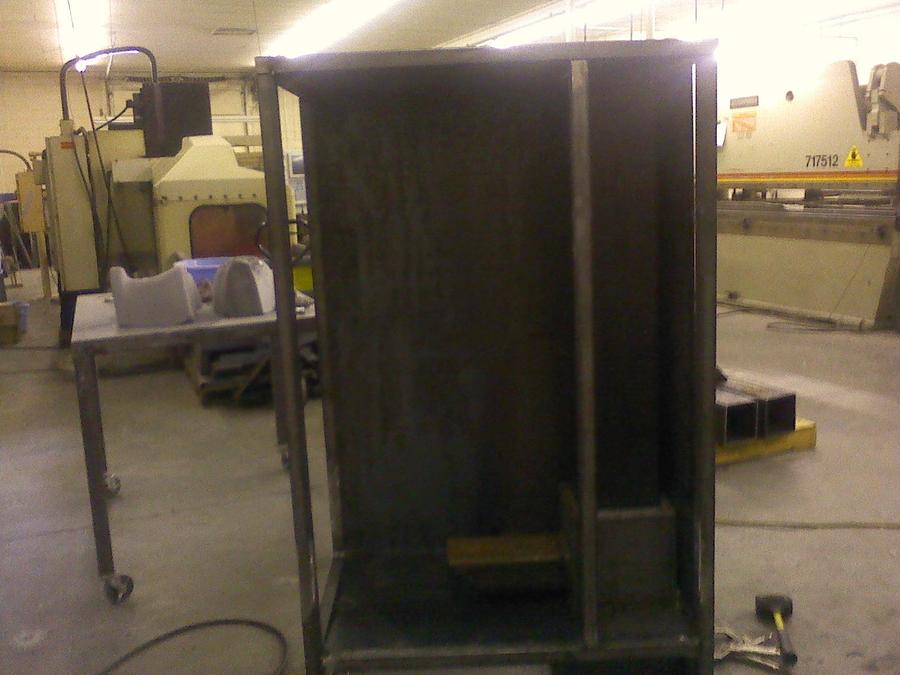I've been asked to post a thread about my smoker build, but I am not sure what "Build" section in most appropriate. So I am going to put it here in the "Other Builds" section. If it fits better somewhere else, perhaps a moderator will relocate it to the proper place.
I joined this site and made a few posts before the forum crash, but have not been active since. Now that my big smoker is operational, hopefully I will make an appearance more often. I've been smoking on a small Brinkman charcoal water smoker since about 2007 or so. Back in early 2011 two friends and I decided to build our own smokers. I am a mechanical engineer, one is a machinist/tool maker, and the 3rd is a KCBS certified BBQ judge. We decided that we wanted a gravity-fed charcoal cabinet-style smoker, so we studied a bunch of "Stump's Clone" builds shown online and took what we thought were the best features and put our own design together. This thread will detail how we got to the end product.
This was not a "hurry up project". We started in April 2011 and worked on it when we had time - busy lives. It was finally finished and at home for my first smoke on 6/10/12... so more than a year in the build of these 3 identical smokers.
I didn't take photos of the raw material or tubing/sheets cut to length/size. We all have seen that before. So my pics start with som of assembly already done. So here are the details:
First of all, these pics were not taken in my garage. We all work together at these smokers were constructed in our metal fabrication and machine shop at work... after hours of course (well, mostly after hours).The first pics show the charcoal chute and firebox already constructed, the framework already welded, adn some of the inner sheet metal skin welded on. But you can still see the basic construction and design at this stage. Many of these are just crappy cell phone pics, so please forgive the quality of some of the photos.
The first pics were taken around 7/7/11.
The charcoal chute is 8"x8" and the heat transfer tube is 4"x6". The firs box is 10'X10"x10".
All of the tubing is 1-1/2" square and sheet metal is 14 gauge.
This pic is to show scope of size. Randall is about 6'4" tall. And this is before wheels/casters
have been added. We were targeting the build height suh that it would roll through my garage door.
This is the fire box with the heat tube that delivers heat and smoke to the cooking chamber.
ThiThis is the ash trap under the fire box.
Opening for the charcoal feed chute on the left.The outlet for the flue on the
cooking chamber has not been cut yet.
I joined this site and made a few posts before the forum crash, but have not been active since. Now that my big smoker is operational, hopefully I will make an appearance more often. I've been smoking on a small Brinkman charcoal water smoker since about 2007 or so. Back in early 2011 two friends and I decided to build our own smokers. I am a mechanical engineer, one is a machinist/tool maker, and the 3rd is a KCBS certified BBQ judge. We decided that we wanted a gravity-fed charcoal cabinet-style smoker, so we studied a bunch of "Stump's Clone" builds shown online and took what we thought were the best features and put our own design together. This thread will detail how we got to the end product.
This was not a "hurry up project". We started in April 2011 and worked on it when we had time - busy lives. It was finally finished and at home for my first smoke on 6/10/12... so more than a year in the build of these 3 identical smokers.
I didn't take photos of the raw material or tubing/sheets cut to length/size. We all have seen that before. So my pics start with som of assembly already done. So here are the details:
First of all, these pics were not taken in my garage. We all work together at these smokers were constructed in our metal fabrication and machine shop at work... after hours of course (well, mostly after hours).The first pics show the charcoal chute and firebox already constructed, the framework already welded, adn some of the inner sheet metal skin welded on. But you can still see the basic construction and design at this stage. Many of these are just crappy cell phone pics, so please forgive the quality of some of the photos.
The first pics were taken around 7/7/11.
The charcoal chute is 8"x8" and the heat transfer tube is 4"x6". The firs box is 10'X10"x10".
All of the tubing is 1-1/2" square and sheet metal is 14 gauge.
This pic is to show scope of size. Randall is about 6'4" tall. And this is before wheels/casters
have been added. We were targeting the build height suh that it would roll through my garage door.
This is the fire box with the heat tube that delivers heat and smoke to the cooking chamber.
ThiThis is the ash trap under the fire box.
Opening for the charcoal feed chute on the left.The outlet for the flue on the
cooking chamber has not been cut yet.
Last edited:



























































